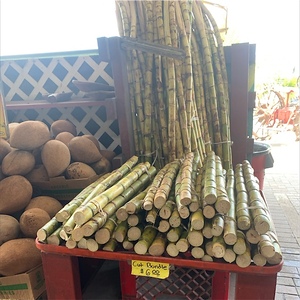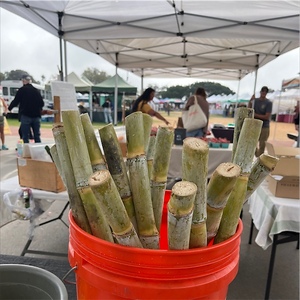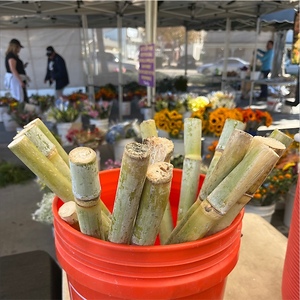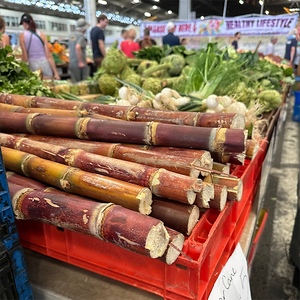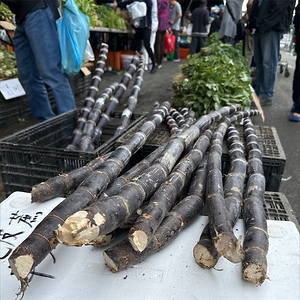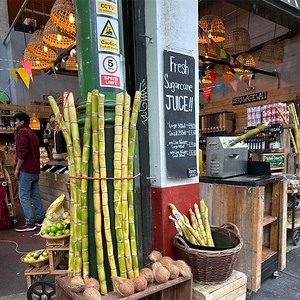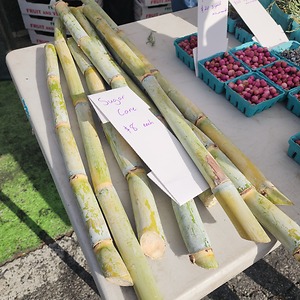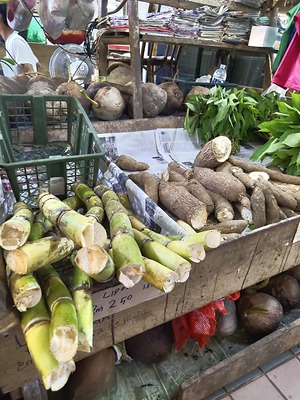


Sugarcane
Estimated Inventory, ea : 0
Description/Taste
Sugarcane varies in size, depending on the species and maturity at harvest. In fresh markets, Sugarcane is typically displayed in its long stalk form and is later cut down to smaller sizes. The stalks, also known as culms, are straight and cylindrical with a curved nature, and average 2 to 5 centimeters in diameter. Each mature, full-grown stalk also bears sections between 20 and 40 jointed nodes. Sugarcane’s exterior resembles bamboo and is firm, taut, smooth, and textured at the nodes. The exterior can appear in shades of green and purple and is hard and inedible. Some species also feature white rings near the joints, called growth rings. Underneath the tough surface, the flesh, sometimes called pith, is dense and fibrous. The ivory to white pith has a slightly spongy, woody texture and encases ample amounts of liquid. The pith is never swallowed and is either chewed and discarded or pressed to extract the juice and then discarded. Sugarcane juice has a sugary, sweet, and starchy taste with subtle floral, grassy, and honeyed nuances.
Seasons/Availability
Sugarcane is available year-round in tropical climates.
Current Facts
Sugarcane, botanically a part of the Saccharum genus, is a category of multiple species belonging to the Poaceae family. The upright, tall-growing perennial grass extends 3 to 6 meters in height and is one of the oldest cultivated crops in history. In the modern day, Sugarcane is present in tropical and subtropical regions worldwide, with the most common species being Saccharum officinarum. Sugarcane is a fast-growing plant that can be cut, grown, and harvested again within 10 to 12 months. The stalks are collected for their sweet juice, which is chewed straight from the flesh or extracted for beverages, syrups, and refining into cane sugar. Worldwide, Sugarcane appears in green and purple shades, and all types are sold under the general descriptor for use in fresh and cooked culinary preparations or for processing.
Nutritional Value
Sugarcane varies in vitamin and mineral content depending on the specific species. In general, it is a source of vitamins B and C that strengthen the immune system and contribute to energy production. The juice also provides minerals like potassium, iron, manganese, calcium, and magnesium. These minerals help balance fluid levels, transport oxygen through the bloodstream, support bone health, and control nerve functions. In ancient medicinal practices like Traditional Chinese Medicine and Ayurveda, Sugarcane is considered a cooling ingredient to remove heat and humidity from the body. The juice is also viewed as a diuretic.
Applications
Sugarcane has a sweet, subtly floral, grassy taste suited for raw and cooked preparations. It is important to note that the Sugarcane has fibrous, indigestible flesh, and only the juice is consumed. Worldwide, Sugarcane is a popular snack sold as a street food. The culms are sold whole in markets, and once weighed and purchased, they are peeled and sliced into smaller pieces by vendors. The pieces can be chewed to extract the juice from the flesh. The fibrous flesh should never be swallowed and is always discarded. Chewing Sugarcane is common throughout Southern, Southeastern, and East Asia, as well as in Africa and Central and South America. In addition to chewing the culms, the liquid from the pith is pressed into a juice. The juice is enjoyed as a cooling drink and is often mixed with ginger and lime. It is also added to mocktails and cocktails in syrup form. Beyond drinks, the juice is incorporated into dishes as a sweetener, especially in puddings, yogurts, ice cream, and jellies. Small pieces of the flesh are used as swizzle sticks in beverages, and the juice is refined into sugar as a flavoring for sweet and savory dishes. The juice is also made into candies worldwide. Sugarcane pairs well with fruits like raspberries, pineapple, orange, and lime, cinnamon, mint, and meats like fish, poultry, and steak. The stems will keep for around seven days when wrapped whole, placed in a plastic bag, and stored on the bottom shelf of the refrigerator. They can also be frozen for extended use.
Ethnic/Cultural Info
Sugarcane is traditionally used as a skewer to flavor chao tom, a well-known shrimp dish in Vietnam. Much of the recipe’s origins are unknown, but most sources point to the city of Hué in Central Vietnam or South Vietnam as the dish’s creation site. Chao tom is comprised of ground shrimp wrapped around slender skewers of Sugarcane. The shrimp is combined with aromatics for added flavor and can be grilled or deep-fried. During cooking, the Sugarcane skewers release their sweet juice into the meat, giving the dish a naturally sweet and savory nuance. Chao tom is eaten as a street food and home-cooked dish throughout Vietnam. It has also become popular for special occasions when served with banh hoi, a dish of delicate rice vermicelli noodles. Banh hoi is a labor-intensive dish, and the noodles are woven into thin sheets. When served together, banh hoi chao tom is a favorite appetizer at weddings and holidays like Tet, the Vietnamese New Year. The rice noodle sheets are wrapped around the grilled ground meat and are topped with lettuce and fresh herbs for a sweet, savory, bright, and herbal taste.
Geography/History
Sugarcane is native to regions of South Asia, Southeast Asia, and Melanesia and has been growing wild since ancient times. Domestication is thought to have occurred in New Guinea around 8,000 BCE, giving rise to Saccharum officinarum, the main domesticated species now found worldwide. Sugarcane later spread throughout East Asia, Polynesia, and early refinements of the juice into sugar occurred in India. Around the 6th century, Sugarcane spread throughout Persia, the Middle East, and into North Africa. It also expanded into Sicily and the Iberian Peninsula around the 8th century. In the 11th century, Sugarcane was introduced into the rest of Europe, and Spanish and Portuguese explorers carried Sugarcane to the New World in the 15th and 16th centuries. After it arrived in the New World, Sugarcane became widespread as a commercial crop for sugar refining and processing. Today, Sugarcane is cultivated in tropical and subtropical climates worldwide. Fresh culms are mainly sold in their growing regions as snacks or juice. Portions of the stalks are also sold through select specialty retailers outside their cultivation areas.
Recipe Ideas
Recipes that include Sugarcane. One
| A Spicy Perspective |
|
Pineapple Sugarcane Water |
| Epicure Asia |
|
Purple Sugarcane Lamb Shank with Purple Butter Potatoes and Roasted Asparagus |



